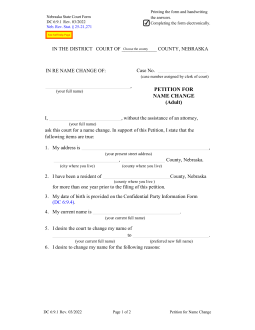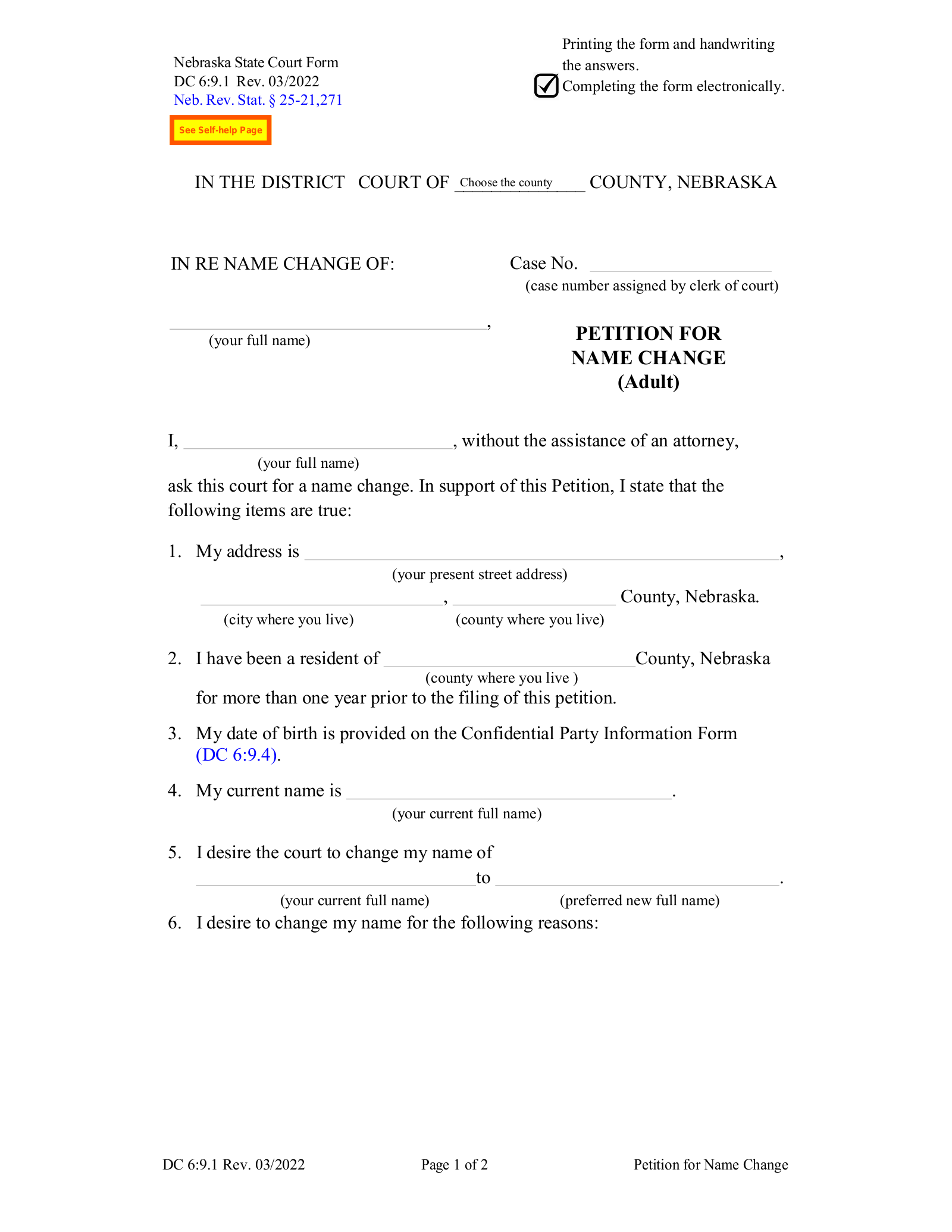Updated April 16, 2024
Nebraska name change forms are used by adult residents to legally change their name for reasons other than marriage or divorce. To be eligible, individuals must have lived in the county where the petition will be filed for at least the past year. Additionally, any person under 19 years old must either be legally emancipated (liberated or independent of their family) or married pursuant to Nebraska law.
Name Change After Marriage
To change your name as part of a marriage, indicate the desired name change on your marriage license application. Once the wedding ceremony has taken place, the officiant will sign the license and submit it to the county clerk. Once the marriage certificate is issued, this serves as legal proof of your name change when you update government registrations, IDs, bank accounts, and more. To obtain certified copies of the marriage certificate, contact the county clerk.
Name Change After Divorce
To change your name as part of a divorce, you may include a request to revert to a previous name in your marital settlement agreement, petition for dissolution, and divorce decree. You will also need to present evidence of your former name to the court. Once your divorce is final, you will be able to obtain certified copies of the divorce certificate from the Clerk of the District Court in the county where it was granted. This certificate can be used as your proof of name change when updating your IDs and registrations.
How to Change Your Name (9 steps)
- Prepare Your Documents
- Pay the Filing Fee
- File Your Documents with the District Court
- Confirm Your Hearing Date
- Publish the Notice of Name Change
- Mail the Published Notice to Interested Parties
- Complete the Decree of Name Change
- Attend Your Hearing
- Obtain Certified Copies of the Decree
1. Prepare Your Documents
If you are eligible to change your name in Nebraska, download and prepare the following documents for filing.[1] Some forms have detailed instructions that should be reviewed before completion:
- Read the instructions for and complete the Petition for Name Change (DC 6:9.1)
- Read the instructions for and complete the Confidential Party Information (DC 6:9.4)
- Complete the Registration of Email Address for Self-Represented Litigant (DC 3:01). The form explains what to do if you do not have access to email.
- Read the instructions for and complete the Legal Notice for Publication (DC 6:9.2)
If publishing the Legal Notice for Publication would put you at risk, skip this form. Instead, you will ask the judge to waive this requirement by preparing the following forms:
- Showing and Request for Waiver of Publication (DC 6:9.5). You will need to provide a reason explaining why publication of the Legal Notice for Publication would endanger you. Any supporting documents need to be attached in hard copy.
- Complete only the top portion of the Order Waiving Publication of Petition to File for Name Change (DC 6:9.6). The court will complete the lower portion if the request is approved.
2. Pay the Filing Fee
When you submit your documents, you must pay the filing fees. If you cannot afford the filing fees, you may submit a Request to Proceed Without Payment of Fees. To submit the request, ask the clerk for the appropriate fee waiver forms. You will need to complete these forms and submit them with your other prepared documents. If your request is approved, you will not be required to pay filing fees.
3. File Your Documents with the District Court
Take the following documents to the Clerk of the District Court in the county where you reside:
- Petition for Name Change
- Confidential Party Information
- Registration of Email Address for Self-Represented Litigant
You should bring photocopies of each of your documents and ask the clerk to stamp them as “filed”. Retain these for your personal records. The clerk will give you a receipt for your documents and a case number will be at the top of the receipt. This is your case number and it must be included on each of your documents.
4. Confirm Your Hearing Date
5. Publish the Notice of Name Change
Once you have confirmed the details of your hearing, you will be able to complete the following form (skip to step seven if the judge waived your publication requirement):
This document acts as legal notice regarding your name change, and it must be published in a local newspaper once per week for four consecutive weeks before your hearing can take place.[2] If you do not complete this step, your hearing will be delayed.
Once the publication of your notice has been completed, the newspaper will provide proof of publication. Some newspapers will send the proof of publication directly to the court; others will give it to you for filing with the clerk.
6. Mail the Published Notice to Interested Parties
- Family members
- Creditors
- Government agencies
7. Complete the Decree of Name Change
Complete the Decree of Name Change (DC 6:9.3). Be sure to leave the date and signature fields blank. You will bring this with you to your hearing. The judge will sign and date it if your name change is approved. Some courts require that you bring more than one completed copy. Before your hearing, check with the clerk’s office to confirm the required number of copies.
8. Attend Your Hearing
You must attend your hearing and you should be prepared to provide testimony. To prepare, read and complete the Instructions for Your Adult Name Change Hearing (DC 6:9).
The judge will consider all of the information and make a decision. If granted, he or she will sign and date your completed Decree of Name Change.
Once it is signed, the judge will give the decree to you or to a court staff member. If the judge gives the decree directly to you, take it immediately to the clerk and file it. Your name change will not be completed if the decree is not filed.
9. Obtain Certified Copies of the Decree
Driver’s License
By law, you are required to apply for a new driver’s license or ID within 60 days of your legal name change.[5] In order to apply for your new driver’s license, you must present yourself at your local driver’s license office with the following documents:[6]
- Current driver’s license
- Evidence of name change (marriage certificate, divorce certificate, court order, or social security card)
- Two different proofs of address (utility bill, bank statement, government check, etc.)
- New, Renewal, and Replacements Data Form
- Required fee[7]
You will be given a temporary driver’s license to use until you receive your new driver’s license by mail. It should take around 14 days for your new ID to be delivered. If you have a vehicle title in your previous name, you should renew your title or obtain a duplicate with your new name.
Voter Registration
Updating your voter registration with your new name can be completed online. If you prefer to update your information by mail or in person, complete the Nebraska Voter Registration Application and mail or deliver it to your county election official.


